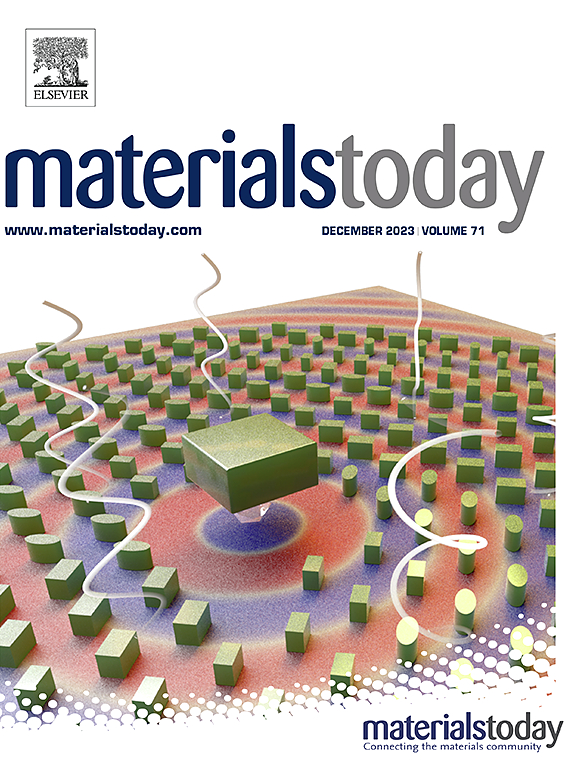用于协同肿瘤细胞周期阻断和免疫调节的工程辐射敏感益生菌增强胰腺癌的放射免疫治疗
IF 21.1
1区 材料科学
Q1 MATERIALS SCIENCE, MULTIDISCIPLINARY
引用次数: 0
摘要
在本研究中,合理设计了一种工程益生菌(CBB),通过肿瘤细胞周期阻断和辐射致敏来增强放射免疫治疗。通过MMP-2敏感肽对厌氧丁酸梭菌(Clostridium butyricum, CB)表面进行铋纳米粒子配位黑磷纳米片(BPs-Bi)修饰,制备工程益生菌CBB。由于CB的嗜氧性,CBB可以主动靶向并渗透到胰腺深部肿瘤,有利于增强BPs-Bi的肿瘤积累和分布。在肿瘤内,BPs-Bi通过调节CDK1和PCNA使肿瘤细胞处于放射敏感的G2/M期,而其高电导率和大比面积有助于电子转移,通过促进ROS的产生来增强bi介导的放射毒性,从而损伤肿瘤细胞。值得注意的是,放射治疗诱导肿瘤细胞释放损伤相关分子模式(DAMPs),同时触发细菌死亡以分泌细菌抗原,从而进一步激发强大的抗肿瘤免疫反应,用于恶性胰腺肿瘤的局部控制和转移缓解,为胰腺癌放射免疫治疗提供了新的机会。本文章由计算机程序翻译,如有差异,请以英文原文为准。
Engineered radiation-sensitive probiotic for synergistic tumor cell cycle blockade and immunomodulation to potentiate radio-immunotherapy in pancreatic cancer
In this study, an engineered probiotic (denoted as CBB) was rationally designed for enhanced radio-immunotherapy through tumor cell cycle blockade and radiation sensitization. The anaerobic Clostridium butyricum (CB) was surface modified with bismuth nanoparticles-coordinated black phosphorus nanosheets (BPs-Bi) through MMP-2 sensitive peptide to prepare the engineered probiotic CBB. Due to the hypoxia tropism of CB, CBB could actively target and penetrate into deep pancreatic tumors, in favor of the enhanced tumor accumulation and distribution of BPs-Bi. Within tumor, BPs-Bi trapped tumor cells in radio-sensitive G2/M phase by regulating CDK1 and PCNA, while its high conductivity and large specific area helped electron transfer to amplify Bi-mediated radio-toxicity via boosting the generation of ROS to damage tumor cells. Worth noted, radiotherapy induced the release of damage-associated molecular patterns (DAMPs) from tumor cells, and concurrently triggered bacteria death to secrete bacterial antigens, which further provoked robust antitumor immune responses for local control and metastasis remission of malignant pancreatic tumors, highlighting new opportunities for pancreatic cancer radio-immunotherapy.
求助全文
通过发布文献求助,成功后即可免费获取论文全文。
去求助
来源期刊

Materials Today
工程技术-材料科学:综合
CiteScore
36.30
自引率
1.20%
发文量
237
审稿时长
23 days
期刊介绍:
Materials Today is the leading journal in the Materials Today family, focusing on the latest and most impactful work in the materials science community. With a reputation for excellence in news and reviews, the journal has now expanded its coverage to include original research and aims to be at the forefront of the field.
We welcome comprehensive articles, short communications, and review articles from established leaders in the rapidly evolving fields of materials science and related disciplines. We strive to provide authors with rigorous peer review, fast publication, and maximum exposure for their work. While we only accept the most significant manuscripts, our speedy evaluation process ensures that there are no unnecessary publication delays.
 求助内容:
求助内容: 应助结果提醒方式:
应助结果提醒方式:


